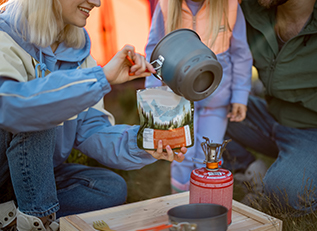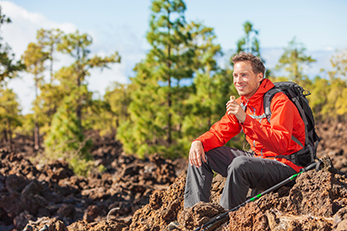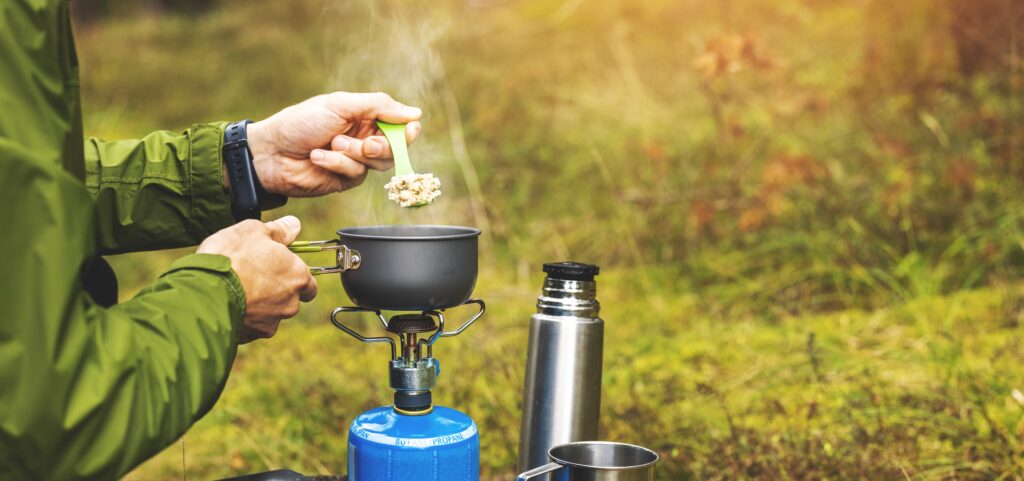When you’re out trekking, it’s definitely hungry work. But you can rely on foraging as you walk. Yet, you don’t want to have to sit down and prepare a meal, either. And, of course, you want to be sure you’re getting the energy you need, too. So, what’s the best way to plan your hiking food for multi-day treks?

Your calorie needs
The first thing to consider is your calorie needs. There’s no one formula to work out how much you need to eat while hiking.
How much food you’ll need depends on numerous factors – the level of exertion, of course, but also your metabolism, age, sex, and even the climate and weather. Nonetheless, when you’re hiking, you’ll need at least 30% more calories than you would usually consume, if not more, on more strenuous days.
How can you meet your needs? Well, the two typical hiking foods—nuts and dried smoked meats — are some very calorific snacks to eat on the go. Packed with fats and protein, meat and nuts give you the energy to keep on trekking.
These energy-dense foods are perfect both as snacks and paired with a convenient carbohydrate as part of hiking lunch ideas.
Food groups – your nutritional needs
Of course, hiking lunch ideas require more than just nuts and carbohydrates. You need to put together a balanced meal. This can be difficult when you’re limited in terms of fresh ingredients.
The fruit found in trail mix is a good starting point, but this isn’t the only thing you can dry. Vegetables like capsicum peppers can also be dehydrated, then rehydrated on your camping stove. Pick up some ready meals in the supermarket to see how they do it.


The weight of the foods
Although you’ll need to bring a certain amount of gear with you when you go hiking, choose lighter gear where possible. You may choose a foil-lined sleeping bag over a thick down one, for example. Similarly, foods that are as light as possible and have minimal packaging are best.
In some cases, pre-made meals with their existing foil or tin can packaging may be the best solution if you need nutritious, portable food that will remain edible for a few days. You could also choose reusable silicone pouches, foil pouches, and sandwich bags, as well as lightweight airtight containers. You can’t exactly lug around a cooler box!
Packing – dividing hiking meals into portions
Speaking of storage and packaging, you’ll also need to think about how you divide your food up as you pack it. Some hikers prefer to snack regularly rather than having three large meals every day. This way, you feel less weighed down, and your muscles have less of a chance to get stiff, so you can keep going. Snacking also gives you more consistent energy levels when hiking.
If you choose this approach, you’ll want easy access to your snacks as you walk. This means something that you can keep in your pocket or at the top of your bag.
On a multi-day trek, you’ll probably want to take a break at least once a day. If you choose to take breaks for meals during your hike, consider putting all the ingredients you need for one-pot meals into one container. This will also help you reduce the amount of cookware you carry. You can get curry sauces in the shop that already contain vegetables, as well as other convenient jar foods and preserves. The glass may make your pack heavier, however, so just pack one or two of these.

The weight of the foods
Although you’ll need to bring a certain amount of gear with you when you go hiking, choose lighter gear where possible. You may choose a foil-lined sleeping bag over a thick down one, for example. Similarly, foods that are as light as possible and have minimal packaging are best.
In some cases, pre-made meals with their existing foil or tin can packaging may be the best solution if you need nutritious, portable food that will remain edible for a few days. You could also choose reusable silicone pouches, foil pouches, and sandwich bags, as well as lightweight airtight containers. You can’t exactly lug around a cooler box!


Packing – divide into portions
Speaking of storage and packaging, you’ll also need to think about how you divide your food up as you pack it. Some hikers prefer to snack regularly rather than having three large meals every day. This way, you feel less weighed down, and your muscles have less of a chance to get stiff, so you can keep going. Snacking also gives you more consistent energy levels when hiking.
If you choose this approach, you’ll want easy access to your snacks as you walk. This means something that you can keep in your pocket or at the top of your bag.
On a multi-day trek, you’ll probably want to take a break at least once a day. If you choose to take breaks for meals during your hike, consider putting all the ingredients you need for one-pot meals into one container. This will also help you reduce the amount of cookware you carry. You can get curry sauces in the shop that already contain vegetables, as well as other convenient jar foods and preserves. The glass may make your pack heavier, however, so just pack one or two of these.
Cooking needs
Another thing to consider is how you’ll cook your meals out in the wilderness. At home, it’s handy to have a larger pot on hand if needed, and to heat up food for as long as necessary. Out on the trail, however, your entire meal needs to fit in the pot you brought, and there’s the risk of your camping stove getting blown out, or even running out of fuel. Therefore, you need to have a sense of how long you can cook the recipes you have in mind using the available fuel. You’re also probably going to be quite tired after all that walking, and won’t want to cook a meal that takes a long time anyway.
Additionally, many hikers report changes to their appetite during hikes, such as a reduced appetite or feeling hungry at an earlier time of day. To adapt to these changes, it’s helpful to have a variety of snacks and meal options, and listen to your body’s hunger cues. So, don’t be surprised if what you planned to eat no longer appeals to you. Be flexible and adjust your meal plan to suit.
Now that you know how to plan your hiking meals for multi-day treks, start creating your own hiking lunch ideas and find your local holiday park here!




